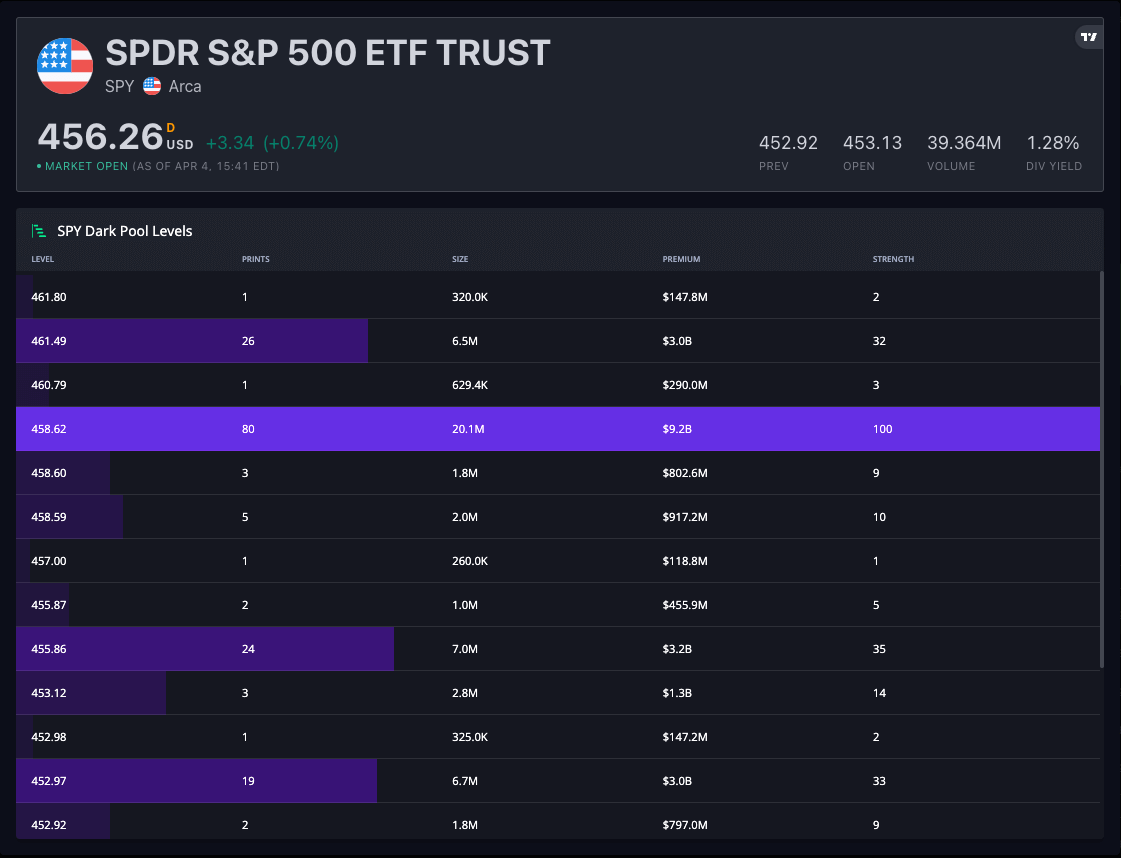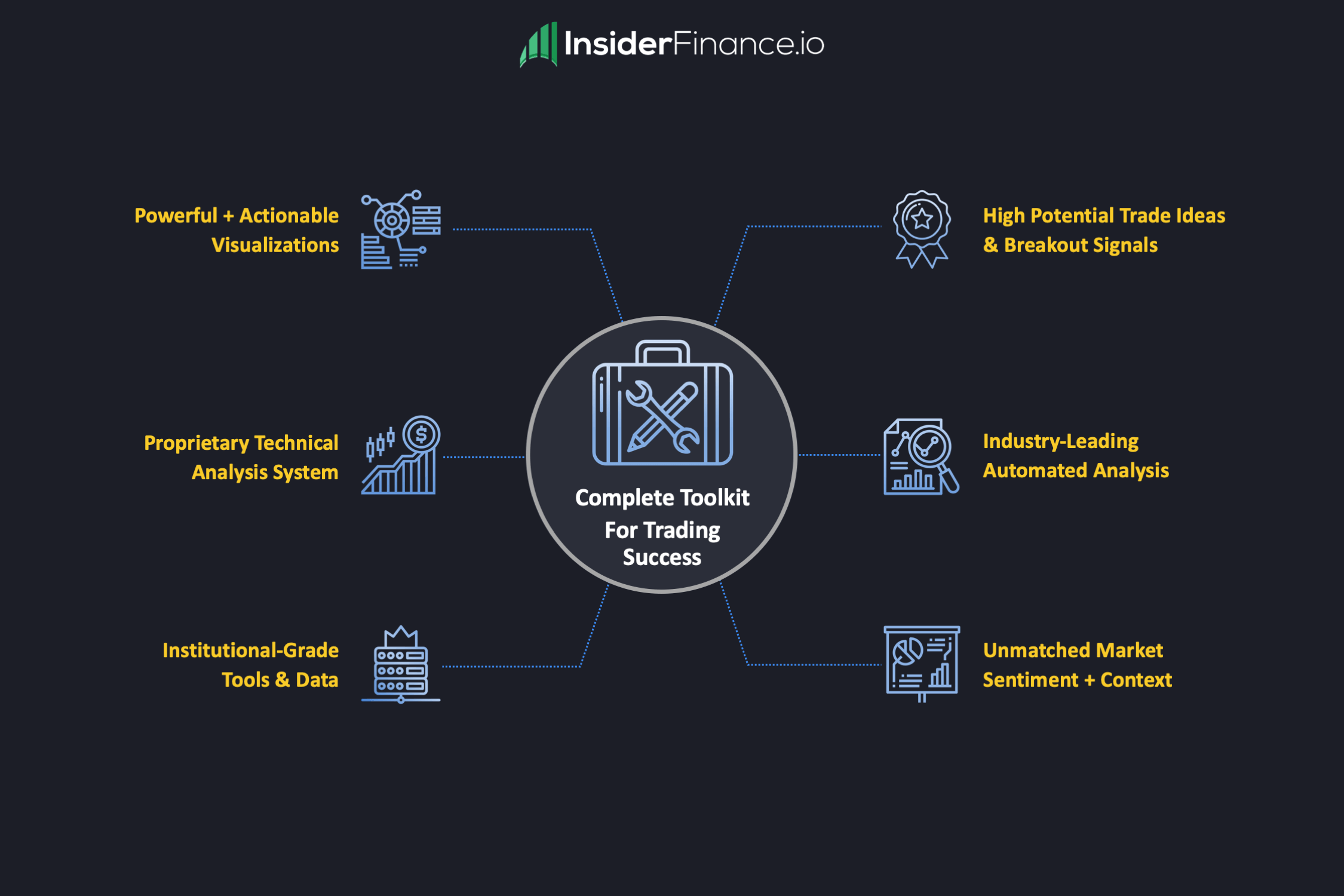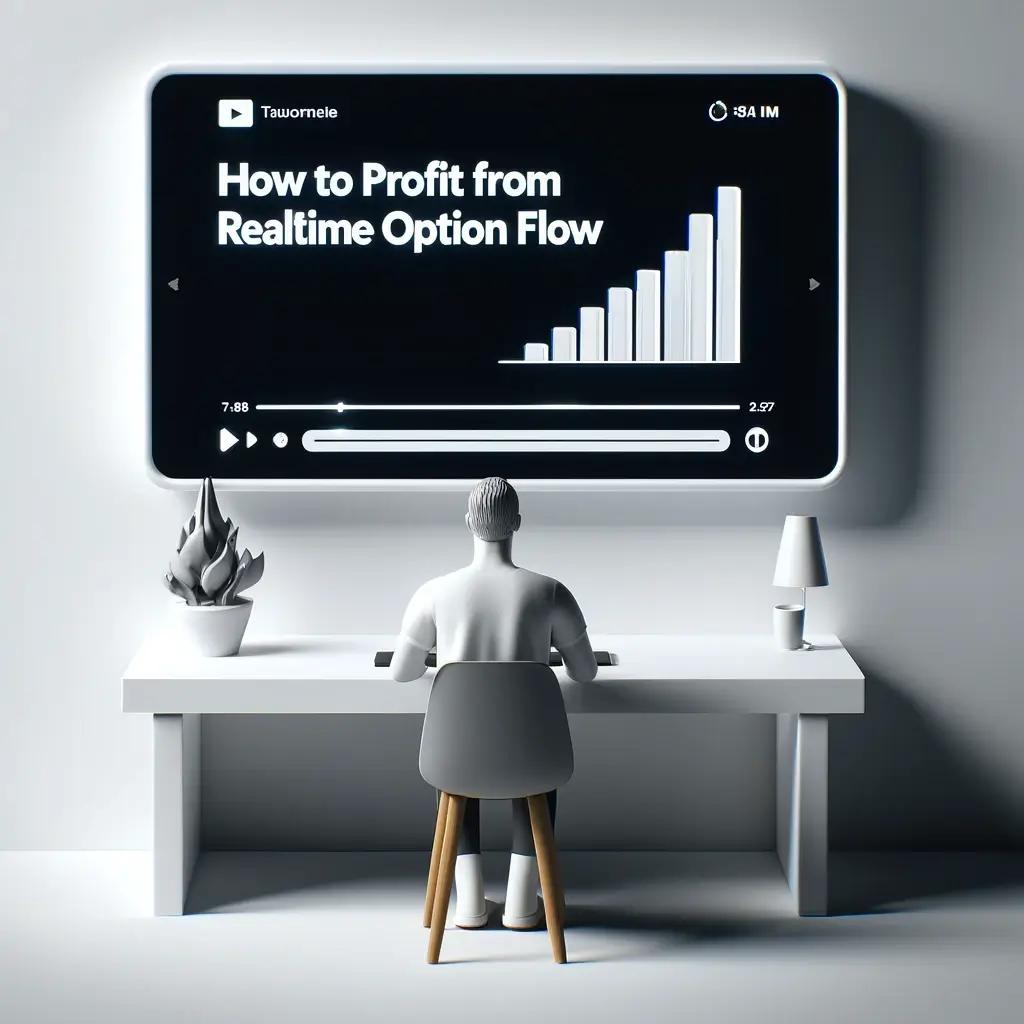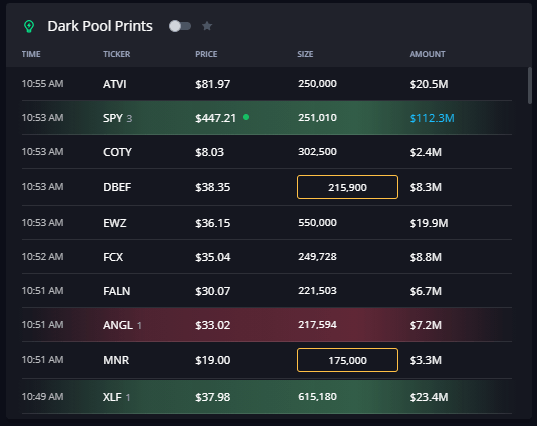Top Reason Why Options Traders Need Dark Pool Data

Ever wondered how top traders stay ahead of the curve? The secret lies in the hidden world of dark pool data – and it’s time you tapped into it.
In the complex world of options trading, gaining a competitive edge often hinges on the ability to predict market movements before they happen. One critical resource for achieving this edge is dark pool data.
Dark pools are private exchanges where large trades are conducted away from the public eye, primarily by institutional investors and significant market participants. Unlike public exchanges, dark pools allow for the execution of substantial orders without immediate market impact, thus providing a layer of anonymity to the traders involved.
The significance of dark pools in financial markets cannot be overstated. These private trading venues account for a substantial portion of the total trading volume. According to a report by the Financial Industry Regulatory Authority (FINRA), approximately 15% of all U.S. stock trades occur in dark pools. This represents a significant amount of market activity that remains unseen by the general public, making dark pool data an invaluable resource for traders looking to understand the full scope of market dynamics.
By tapping into this data, options traders can uncover insights that are not available through traditional market channels. The ability to see the trading activities of institutional investors—who often have access to superior research and resources—can provide early indications of potential market shifts. This foresight enables traders to position themselves advantageously, making more informed decisions and managing risks more effectively.
Understanding the role of dark pools and their impact on market movements is essential for any serious options trader. In the following sections, we will delve deeper into how dark pool data provides critical market insights, aids in making informed decisions, and enhances risk management strategies.
Unveiling Institutional Trades for Market Insights

Dark pool data provides a window into the trading activities of institutional investors. These large trades, often conducted in secrecy to avoid impacting the market, can be precursors to significant price movements.
When institutional investors make large trades, it typically signals their expectations of future market trends. By analyzing this data, options traders can identify early indications of potential market shifts, allowing them to position themselves advantageously.
Historical Context
Dark pools have evolved significantly since their inception. They originated in the late 1980s as private forums for large institutions to trade blocks of stocks without revealing their intentions to the public market. The goal was to prevent large trades from influencing market prices, which could happen if such trades were executed on public exchanges.
Over the years, the use of dark pools has grown, especially with advancements in technology and increased regulatory scrutiny aimed at maintaining market fairness. Today, dark pools are a critical component of the financial ecosystem, allowing for the efficient execution of large trades while minimizing market impact.
Case Study: Early Signals from Dark Pool Activity
One notable example of dark pool data providing early market signals is the 2010 flash crash. On May 6, 2010, the U.S. stock market experienced a sudden and severe crash, with the Dow Jones Industrial Average plunging nearly 1,000 points within minutes.
In the aftermath, analysis of dark pool data revealed that significant selling activity had occurred in these private venues leading up to the crash. Large institutional investors were offloading their positions in a stealthy manner, which eventually contributed to the drastic market decline. This case underscores how dark pool data can serve as an early warning system for potential market disruptions.
Statistics on Institutional Trades and Market Shifts
Numerous studies have shown that institutional trades often precede major market movements. According to research published by the Journal of Financial Economics, approximately 60% of significant market movements can be traced back to large trades executed by institutional investors.
Furthermore, a study by Greenwich Associates found that nearly 40% of equity trading volume in the U.S. is executed through dark pools. This substantial volume highlights the critical role that dark pools play in reflecting the intentions of major market participants.
By monitoring dark pool data, options traders can gain valuable insights into the likely direction of the market, enabling them to make more informed and strategic trading decisions.
HIGH POTENTIAL TRADES SENT DIRECTLY TO YOUR INBOX
Add your email to receive our free daily newsletter. No spam, unsubscribe anytime.
Leveraging Non-Public Information for Informed Decisions

Access to dark pool data empowers options traders to make more informed decisions. Understanding the actions of influential market players provides a strategic advantage that goes beyond what is available through public exchanges. This information can help traders discern the true sentiment and market direction, allowing them to make trades with greater confidence.
In-Depth Analysis
Dark pool data serves as a powerful complement to other market indicators. Traders often use it alongside technical analysis, which involves studying past market data to predict future price movements, and fundamental analysis, which evaluates a company's financial health and market position. By integrating dark pool data with these methods, traders can gain a more comprehensive view of the market.
For example, if technical analysis suggests a bullish trend and dark pool data reveals significant buying activity by institutional investors, traders can be more confident in their decision to go long. Conversely, if technical indicators are mixed but dark pool data shows heavy selling, it might prompt traders to take a more cautious approach.
Statistics on Success Rates
The impact of dark pool data on trading success is well-documented. A study conducted by the CFA Institute found that trades informed by dark pool data had a 15% higher success rate compared to those that were not. Additionally, research by the Tabb Group revealed that traders who utilized dark pool data as part of their strategy experienced a 20% improvement in their overall trading performance.
These statistics highlight the tangible benefits of integrating dark pool data into trading strategies. By leveraging this non-public information, traders can make more accurate predictions, reduce risks, and enhance their overall trading outcomes.
Anticipating Large-Scale Market Movements for Risk Management

Dark pool activity can be a crucial tool for risk management. By keeping an eye on significant trades, options traders can anticipate large-scale buying or selling that might impact the market. This foresight allows them to manage their risks more effectively, ensuring they are not caught off guard by sudden market shifts.
Historical Analysis
Historical examples highlight the importance of dark pool data in managing risks during market turbulence. One prominent instance is the 2008 financial crisis. In the months leading up to the crisis, dark pool data showed an increase in sell-side activity by institutional investors. This early signal indicated a lack of confidence in the market, which was not immediately apparent in public exchanges. Traders who paid attention to these dark pool signals were better prepared to adjust their positions and avoid substantial losses as the crisis unfolded.
Another example is the Brexit referendum in 2016. Prior to the vote, dark pool data revealed significant hedging activities and large trades by institutional investors anticipating market volatility. This early warning allowed traders to manage their exposure to European markets and implement protective strategies, mitigating potential risks associated with the unpredictable outcome of the referendum.
Statistics on Avoiding Losses
Data on the impact of monitoring dark pool activity on risk management is compelling. According to a study by Aite Group, traders who actively monitored dark pool data were able to reduce their portfolio losses by an average of 12% during major market downturns.
Furthermore, a report by ITG found that traders who incorporated dark pool insights into their risk management strategies experienced a 15% improvement in their risk-adjusted returns compared to those who relied solely on public market data.
Real-World Example
A practical example of dark pool data in action comes from a major hedge fund during the COVID-19 pandemic. As early as January 2020, dark pool data showed a spike in sell orders for stocks related to travel and hospitality.
Recognizing the potential for a global economic slowdown, the fund swiftly adjusted its positions, reducing exposure to vulnerable sectors and increasing holdings in defensive stocks. This strategic shift helped the fund minimize losses during the market downturn in March 2020.
Maximize Your Trading Edge with InsiderFinance

InsiderFinance provides a powerful platform for intelligently monitoring dark pool activity, giving you the edge you need in the competitive world of options trading. By leveraging InsiderFinance's comprehensive tools and insights, you can unlock the full potential of dark pool data to make smarter, more informed trading decisions.
Benefits of Using InsiderFinance:

- Intelligent Dark Pool Data: Gain access to institutional-grade dark pool trading information with intelligent highlighting, allowing you to stay ahead of market movements.
- Support and Resistance Levels: Identify support and resistance levels by tracking dark pool prices over time with Dark Pool Levels.
- Advanced Analytics: Utilize sophisticated analytical tools to interpret dark pool activity and integrate it seamlessly with your trading strategy.
- Institutional Insights: Understand the actions of institutional investors, providing you with a strategic advantage.
- Risk Management: Enhance your risk management strategies by identifying large-scale trades and potential market shifts before they occur.
- User-Friendly Interface: Benefit from an intuitive platform designed to provide actionable insights quickly and efficiently.
Don't miss out on the opportunity to elevate your trading strategy with InsiderFinance. Sign up today and start making more informed, confident trading decisions with the power of dark pool data at your fingertips. Try InsiderFinance now and experience the difference.
HIGH POTENTIAL TRADES SENT DIRECTLY TO YOUR INBOX
Add your email to receive our free daily newsletter. No spam, unsubscribe anytime.
FAQs
What is dark pool data and how is it used in options trading?
Dark pool data refers to the trading information from private exchanges where institutional investors execute large trades without public disclosure. Options traders use this data to gain insights into potential market movements.
Why is dark pool data important for options traders?
Dark pool data is crucial for options traders as it provides early indications of significant market moves, helping them make informed decisions and manage risks effectively.
How can dark pool data provide early market signals?
By revealing large trades by institutional investors, dark pool data can signal upcoming market trends, allowing traders to anticipate price changes.
What historical events highlight the importance of dark pool data?
Events like the 2008 financial crisis and the 2010 flash crash showcase how dark pool data provided early warnings of market disruptions.
How does dark pool data complement technical and fundamental analysis?
Dark pool data offers a layer of insight that, when combined with technical and fundamental analysis, gives traders a more comprehensive view of the market.
What are the success rates of trades informed by dark pool data?
Studies show that trades informed by dark pool data have a 15% higher success rate compared to those that rely solely on public data.
How can dark pool data improve risk management for options traders?
By monitoring dark pool activity, traders can anticipate large-scale market movements and adjust their positions to mitigate risks.
What are some real-world examples of dark pool data in action?
Examples include the early sell-off signals before the 2008 financial crisis and the hedging activities leading up to the Brexit referendum.
What are the benefits of using InsiderFinance for dark pool data analysis?
InsiderFinance offers real-time data, advanced analytics, institutional insights, enhanced risk management, and a user-friendly interface for smarter trading decisions.








